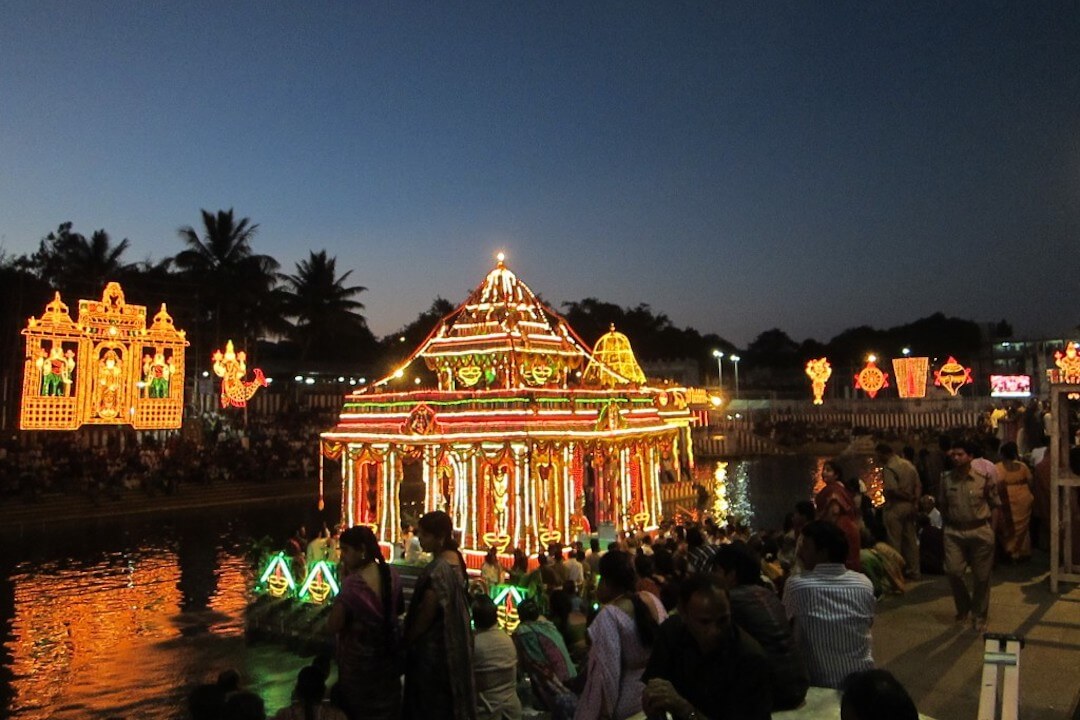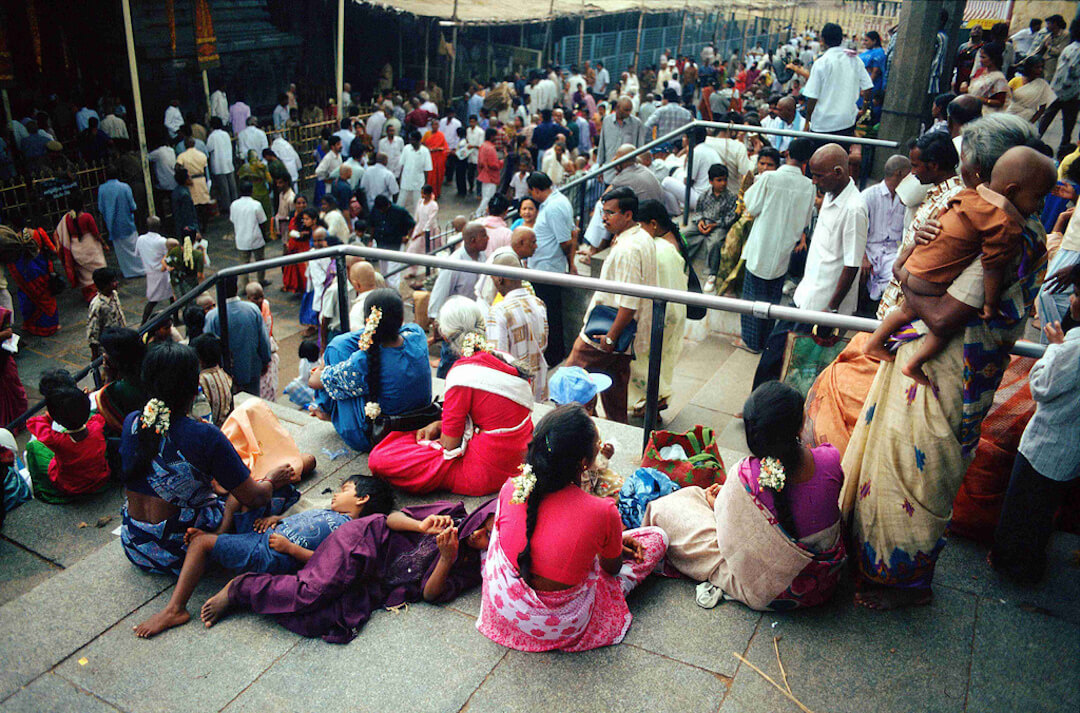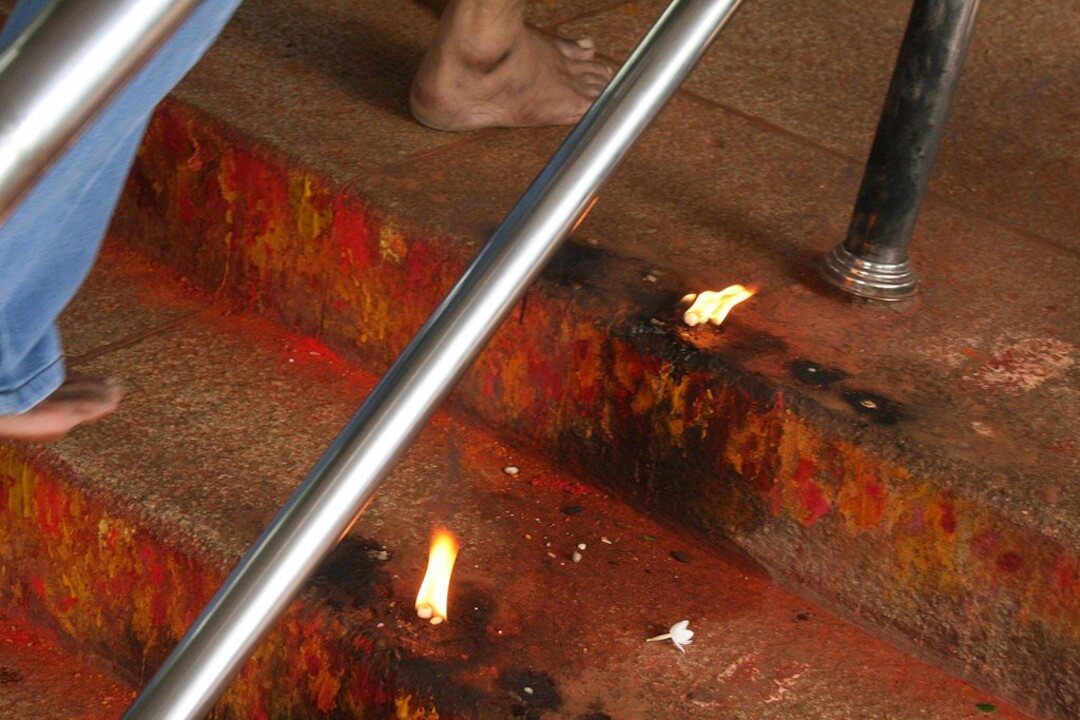Darshan at Venkateswara Temple – one of India’s most incredible experiences
Today was one of those days in India when you remember why it is one of the most fascinating countries on the planet (and believe me there are many days when you think this is not the case).
We flew from Hyderabad to what we thought would be the small town of Tirupati (it is, in fact, larger than imagined and if you read the facts below it will become obvious why) to visit one of (if not the) most important places of worship in all India – and indeed the world. We knew very little about the place apart from the above fact and didn’t know what to expect but thought it must be worth a punt with a statistic like that?
 Credit: Dinesh Kumar (DK)
Credit: Dinesh Kumar (DK)
The temple (known as Venkateswara, an avatar of Lord Vishnu) is about an hour away from Tirupati near a town called Tirumala and the first thing we needed to do was obtain a ‘darshan’ time (literally ‘deity viewing’ or ‘time slot’ in my language!). This was unusual in itself in that in order to get right into the heart of the temple (which is not normally possible for non-Hindus in many temples) we technically had to become pilgrims for the rest of the day, make our donation (£1.25 each), join the queue and enter the inner sanctum with the rest of the pilgrims.
So, we purchased our ‘darshan’ ticket with no problems, stripped ourselves of all things leather, left our shoes, cameras and mobile phones in the car and headed off to the ‘holding cages’ (literally!). We breezed through cages 15-3 just like that (good times) and hit the queue in cage 2. Not bad we thought, only two cages to go and we will be in.
At this point, I should explain the ‘darshan’ system. There are 4 types:
- VIP ‘darshan’ for Rs500 that pretty much fast tracks you to the inner sanctum within, at a guess, 30 minutes or so.
- Rs100 ‘darshan’ which gives you an allocated time to enter the queue. This is what we opted for. Our time was between 3pm and 4pm, for example, and if you missed your time it was tough. Having just been to Euro Disney, I likened it to the fast track system that they have there. The average queuing time is 5-6 hours.
- Rs50 ‘darshan’ is as above but with longer queuing time (approximately 8 hours).
- Free ‘darshan’, again as above but with queues that are beyond my imagination (at least 12 hours). People who opt for this don’t have to stand in line for all this time but are initially held in large waiting rooms (or holding pens) where they are fed and watered and have access to a bathroom. They move from one waiting room to the next until they join a queue at around the 2-hour point.
 Credit: Christian Ostrosky
Credit: Christian Ostrosky
Why didn’t we opt for the VIP ‘darshan”? Simple: we didn’t know about it! We also didn’t know (although it is obvious if you think about it) that all queues eventually meet to enter the inner sanctum (bad times) so although we were in cage 2 we still had to get to this point, battle the ‘meeting of the rivers’ and get in to see the deity. It is difficult to put a lot of the experience into words but the whole queuing up thing, the people we got talking to, the general atmosphere, the temple/inner sanctum itself and even the organisation and security was out of this world. We were very lucky on the queuing front and were in front of the deity just within the 2 hours mark. As you finally come face to face with the deity you are supposed to make a wish/say a prayer but I was so taken with everything going on around me that I forgot to make mine and Kirsty won’t tell me what she asked for!
When the queue cages end and the crowds meld into one, there is an incredible rush to the inner sanctum with people pushing and jostling from all sides. As you reach the final approach to the deity itself people are so wrapped up in their devotional thoughts, some are trance-like, others chanting in unison and most holding their hands above their heads in prayer. There is barely time to take it all in.
 Credit: Shashi Bellamkonda
Credit: Shashi Bellamkonda
After the ‘viewing’ we simply hung around the temple taking it all in and enjoying that rarest of things in India; not being hassled and left in peace! In fact, the whole experience was hassle-free and one that we will remember for a very long time.
Some facts about Venkateswara temple
- About 50,000 to 100,000 pilgrims visit the temple daily, while on special occasions and festivals the number of pilgrims shoots up to 500,000.
- Typically, devotees spend between 1 and 12 hours going through the ‘Queue Complex’, depending on the season and the amount they have paid.
- Many pilgrims shave their head (male and female) as an offering to the deity. The temple collects over a ton of hair each day which is sold a couple of times a year to international buyers at auctions and used for hair extensions. It brings in over US$6m each year in revenue.
- The overall revenue for the temple in 2008 was 10 billion rupees and most of this came from donations from visitors.
And some things that we learnt (tips for visiting Venkateswara temple)
- Pee before joining the queue.
- Take water (but not too much, see point 1).
- Don’t even think about going if you get even mild claustrophobia<
- Don’t let anyone push in (use elbows to the maximum and stand side by side to prevent queue jumping). You build up a camaraderie with the people in front and behind you and join forces to stop others from pushing past you.
- Don’t go in the summer – we were OK but in the summer months, you would melt.
- Avoid weekends and festivals (even more pilgrims turn up).
- Try not to dwell too much on the health and safety implications!
- Most importantly, go with the flow. At times you will be crushed and literally swept off your feet but as you are a foreigner and this is India there is always someone looking out for you.
If you ever get the chance then go, it is one of the most incredible experiences you will ever have in India.
PS from Kirsty
People talk about the temple having incredible energy that you can feel; Mark would call it “spiritual mumbo jumbo” but I would say they are definitely right!
Unfortunately, we don’t have any of our own photographs of Venkateswara Tirupati because cameras aren’t allowed inside the temple complex. The pictures in this post are courtesy of Flickr Creative Commons and photographers have been duly credited where required. Although they are not the best quality, hopefully, they will convey a little of the incredible atmosphere within the temple.
READ MORE BLOG POSTS ABOUT INDIA
